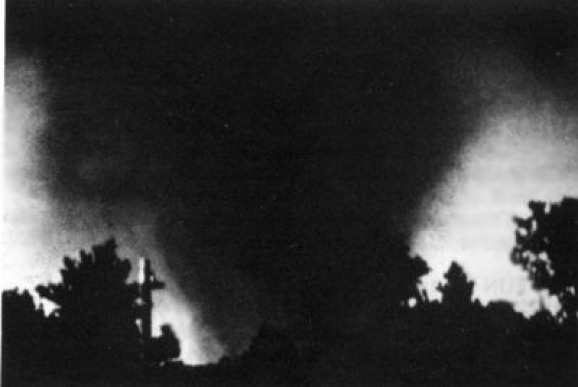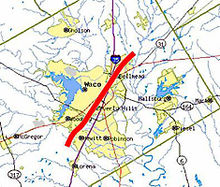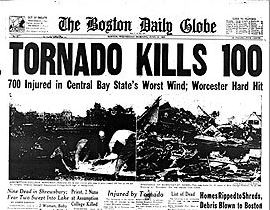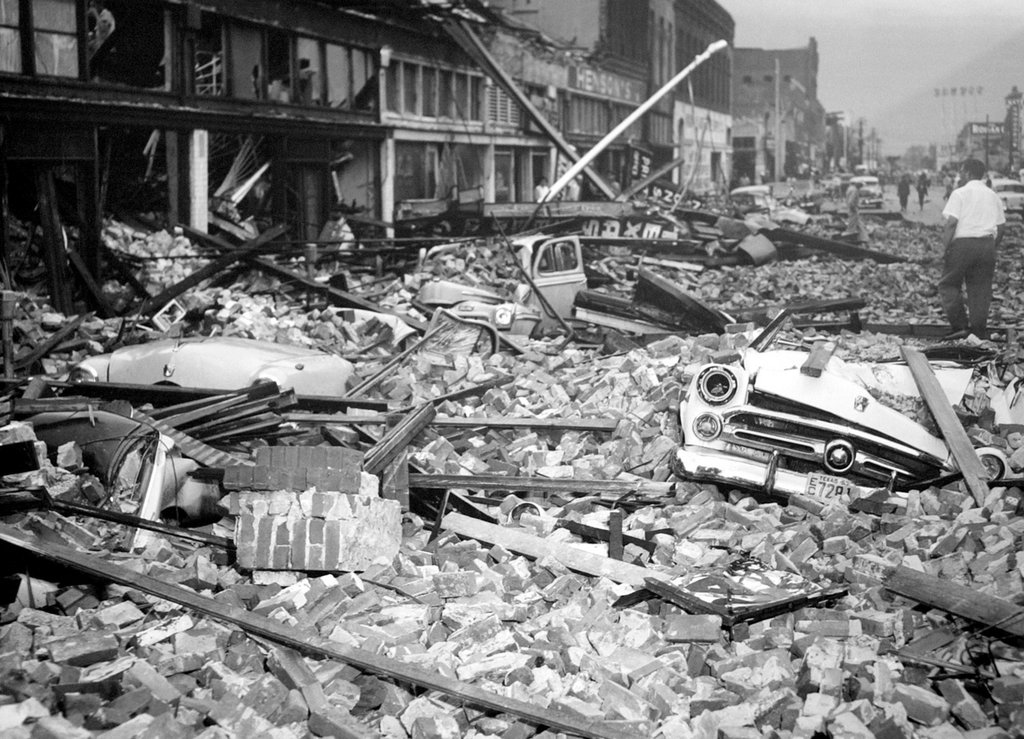On this date, exactly 64 years ago in east-central Texas, a muggy and windy lunch hour would quickly lead to black skies and a huge tornado barreling right into downtown Waco. At 4:36pm the F-5 twister, with winds over 200 mph, would flatten entire city blocks -- some partially, others wholly -- burying people alive, under fallen bricks and debris. 114 would die and 597 would sustain injury. It would tie with the 1902 Goliad tornado as the deadliest in Texas history. However, this tragedy led to change.

The red line indicates the path the May 11, 1953 twister took, destroying the long held myth that, "a tornado can not hit a downtown area". This one destroyed 346 buildings. It also led to public demand for better weather warnings, but it would take great public pressure for this to happen.

1953 was a year of extreme tornadoes, including the "Worcester tornado", which killed 100 people in central Massachusetts and injured 700. It was an F-4, completely knocking over structures to rubble. A few days earlier with a nearly identical death toll was the, "The Flint Tornado", which killed 90 in Michigan and was labeled an F-5, completely pushing structures off their foundations.

Beyond the year being extremely active, weather warnings then weren't what they are today. In fact, the Weather Bureau would not mention the word, "tornado" in their forecasts or their warnings, as to avoid causing unneeded alarm and panic. Can you imagine?
Of interest, the US Air Force did receive an early version of tornado warnings during this time, in an effort to protect their expensive airplanes. Unfortunately, these warning were not shared with the general public.
Along with public demand came the advent of new radar technology. By 1957, radar designed to spot storms would be distributed nationwide, allowing meteorologists to detect bad weather in real time, instead of deducing a storm's trajectory based on reports -- and issue somewhat accurate warnings. (Remember, this was before weather satellites, so radar was a big deal!) For the first time, a storm could consistently be tracked on a map and warning broadcast to towns in its path. Essentially the 1953 tornado would start a movement to improve how warnings were given, in turn, saving countless lives in the decades to follow.
In some cases, if the storm passed close enough the radar site, a hook-shaped radar echo could be spotted -- which many times indicated a tornado in progress or developing.

This dubious anniversary is also a reminder that we are in the heart of our severe storm season. While Waco is a three hour drive north from Houston and closer to what's considered, "tornado alley", we're not immune from violent tornadoes. In 1992, an F-4 monster raked across Channelside and before that, Galveston in 1961.1
While monster twisters are rare here, Harris County does have the highest annual frequency of tornadoes than any other in the United States! Thankfully they are typically weak EF-0 to EF-1. We get so many due to our vicinity to Galveston Bay and its waterspouts, plus tornadoes spawn when tropical systems approach, along with the occasional spring and fall storm system from the Midwest.
By the way, Hurricane Season begins in a few weeks, on June 1st. Be sure to have your preparations in order as our area is due for a strike. Statistically Houston sees a hurricane once every 8 years. Ike was the last -- 9 years ago.
1From Wikipedia, "This [tornado developed from the supercell that generated the Hobby Airport tornado and first touched down near the Houston Ship Channel, snapping trees in a wooded area. The tornado then rapidly intensified and widened to 1 mile shortly after touching down, reaching F4 intensity as it moved through several subdivisions in the Channelview area, where the most severe damage occurred. 271 homes were heavily damaged or destroyed, and 14 were left with no walls standing. The tornado crossed the San Jacinto River before dissipating near Dayton. Despite having been a large and intense tornado, the storm only produced 15 injuries and no deaths along the entire path. It was one of only two recorded F4 tornadoes in Greater Houston, the other having hit Galveston on September 12, 1961."



